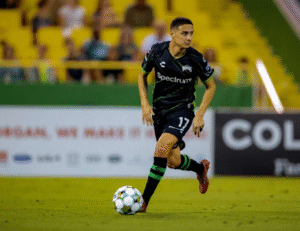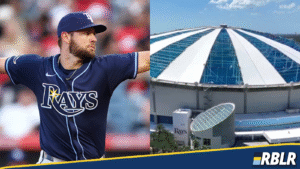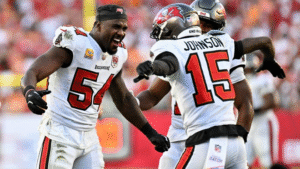Buy Low, Sell High: Free-Agent Starters with Upside

After suffering a multitude of injuries to the starting rotation last year with multiple TJS surgeries and waiting for the rehabbing mini-deGrom, Shane Baz, the Rays find themselves in need of SP depth once again heading into the ‘24 season.
There is some depth in Durham and in Montgomery like Jacob Lopez, Mason Montgomery, and Cole Wilcox, but the Rays need proven, upside-driven, major league talent. Although signing an ace in Aaron Nola or a rebounding Lucas Giolito would be wonderful for the team from a leadership, PR, and upside standpoint, these pitchers are due to receive massive contracts in free agency heading into the off-season, which is something that the Rays typically abstain from dishing out (no WS champ Jordan Montgomery either). This article focuses on a number of starting pitchers who possess upside, the ability to throw meaningful, efficient innings, and a high likelihood to sign with the team.
Here are some notable names that could have their number called — Lance Lynn (36), Jack Flaherty (28), Frankie Montas (30), and Luis Severino (29).
The Fallen Ace
Lance Lynn possesses a supination arsenal, meaning he generates cut and sweep naturally, and is my favorite well-known SP that the Rays could sign; his last year was atrocious according to a variety of counting stats, in which he gave up the most home runs in the majors — 44 — and 4 extra long-balls in his start against the D-Backs this postseason, but I think that there is so much more in the tank for the veteran and former ace.
The biggest issue for Lynn is his FF (four-seam fastball) quality regression as his FF has previously been one of the best in the majors via Baseball Savant’s Run Value leaderboard: the 18th best in ‘21 at 16, 93rd best (top 1%) in ‘20 with a +6, and 2nd best in ‘19 with a whopping +32 Run Value.
His FF sounds like a really great pitch, right? This year it posted above average results in underlying metrics like whiff % and xwOBA; however, the FF was in the bottom 1% in terms of run value, posting a -9 RV. The main driver in his FF’s quality drop-off is its velocity and carry. From ‘19-’23, Lynn lost two miles per hour and 2.5 inches of carry. FF quality isn’t impossible to fix as adjusting spin efficiency and finger placement create better shapes for FFs, but I think that his FF’s quality was poor because teams might have been leaning Lynn into more cut as it’s natural to his supination bias. Cut FFs also post solid xwOBAs and generate tons of weak contact (STL cut Jack Flaherty’s FF in hopes of doing something similar).
The answer for returning Lynn seems fairly obvious; throw the FF less and rely on his other pitches which all possess unique movement due to his supination bias. One pitch that Lynn would benefit from throwing more often is his gyro SL which posts strong xwOBAs against both hands with a .178 xwOBA versus RHBs and a .285 xwOBA v. LHBs. The SL varies in shape as he threw a cutterish shape in ‘22 and switched to a bigger gyro breaker in ‘23. One issue that seems to come up with his SL is an issue in location, most notably missing the outer third against RHBs. Lynn’s FC is a great offering versus LHBs (.330 xwOBA!); Lynn’s CU, which is really just a sweeper and curveball in name only, presents a challenge to RHBs with a 35.4% whiff and .343 xwOBA. Lynn needs larger targets for his breaking balls to get him in-zone more often which will create more positive results due to his high-level stuff.
Serviceable with Upside
Jack Flaherty has the most potential to fulfill due to relatively young age (28), high prospect and draft pedigree, and previous stuff. Flaherty is a supinator and can throw multiple plus pitches well. Flaherty suffered strange velocity fluctuations throughout his last two years in the big leagues, especially with the Cardinals.
A couple of things that Flaherty does well: limits hard contact, gets great extension, and generates three intriguing breaking ball shapes.
A couple of changes that Flaherty could make are leaning into his supination bias through seam-shifted wake, which occurs when a pitch remains as a perfect circle on one side, catching the seam and gaining inferred movement, in which he’d develop a sweeper (SW), sinker (SI), and change-up (CH), cleaning up his mechanics by getting a less pushy arm action and more into his pec to generate his throw, and adjusting his pitch usage to both hands.
Flaherty has great pitch shapes and should leverage his arsenal’s diversity in collecting more whiffs and weak contact. Flaherty struggles with LHBs (left-handed batters) via the xwOBA metric, so increasing his usage of CUs and CHs while reducing his SL, SI, and FC should drastically improve his results. His FC is above avg. pitch movement-wise, but LHBs had a terrific season with a .474 xwOBA against the pitch.
A potent pitch mix against RHBs (right-handed batters) would be leaning on a SI-SW-FC mix with occasional CUs and FFs. A middle-middle target creates more in-zone opportunities for Flaherty (10.2 BB% or bottom 23% in league), and if Flaherty can’t successfully perform in a starting role, his stuff will definitely play-up in a bulk/high leverage role.
There is little doubt as to how good Jack Flaherty can be — just look at his start versus the Rays on 9/15/23 in which he had 6Ks in 4IPs w/ 1BB. Flaherty threw his hardest pitch of the season to Brandon Lowe, a 97.2 MPH FF.
Frankie Montas represents a higher-ceiling, rehab project due to his high-octane pronation bias, headlined by a filthy SPL. Montas posted strong chase rates and hard hit%/avg. exit velocity numbers in ‘22 — top 14% and top 22%/29% respectively.
Montas throws two fastball shapes, a SI and FF, and two breaking ball shapes, a SL and FC, to go along with his lethal SPL. He threw his FF more than his SI in ‘22 with his FF posting better results. The issue with Montas’ breaking balls is that their movement profiles are extraordinarily similar which is an advantage to hitters because they can sit on one breaker and run into the other with authority. Developing vertical or horizontal separation between the two breakers is pertinent — I contend that Montas should make the SL depthier or sweepier, which he can do by utilizing a spike grip, and keep the FC shape which has strong velocity and depth.
Instead of having both shapes, Montas could opt to blend the two and perhaps add a KNCV (knuckle-curve), adding a hard, downward-breaking gyro pitch. His command/BB% (walk rate) is around league average; however, adding larger pitch targets like a middle-middle target or cues could make his walk rate lower and his strikeout rate higher.
If the Rays do sign Montas, they need to be wary of his shoulder’s health. He made one appearance this year after dealing with a shoulder injury that occurred at the end of last season. One factor that probably affected his shoulder is Montas’ seemingly pushy throwing motion. Over-relying on the shoulder and not getting into a deeper pec stretch to throw the ball causes shoulder fatigue and injury.
A healthy Frankie Montas could do wonders for the Rays and bolster an injured pitching staff, and the Rays could do wonders for Frankie Montas’ career, wallet, and postseason success by giving him a chance to prove his big-league capability once more.
Luis Severino possesses a strange arsenal due to his ability to throw a unique two-plane SL, riding FF, and hard, two-plane FC. Severino also throws a CH and SI with mediocre movement profiles. The FC is the pitch that determines if the rest of his arsenal clicks or not because of its ability to bridge the distinct movement profiles of his FF and SL and posted a .261 xwOBA and 40.5% whiff in ‘22. Over 40 IPs struggled with results this year, particularly on damage coming against his elite FF. His FF posted a .455 wOBA, greatly underperforming its .405 xwOBA, and RHBs destroyed his FF to the tune of a .726 SLG!
Severino needs to mix more pitches versus RHBs like his CH, FC, SL, and SI. These pitches would give his FF more room to play against same-handed hitters. A concern that teams will have with signing Severino: his recent injury woes. Severino recently came back from TJS (Tommy John Surgery) and suffered an oblique strain that ended his season, creating uncertainty about his overall health and most likely decreasing his value of the unrestricted free-agent market.
Luis Severino possesses a ton of upside and is not too far-gone from his ace-like 2018 season. Adjusting pitch usage and slightly tweaking his arsenal would give Severino much more success. An acquiring team’s goal should be to keep Severino as healthy as possible and let the 29-year old dominate opposing hitters once more while giving him large targets to attack and instilling faith that he can reach new horizons.
Projects
Two other starters that are options for the Rays to sign: Tyler Mahle and Brad Keller.
Mahle, although recovering from TJS and most likely unable to contribute at full capacity next season, deserves a worthwhile, two to four year contract to aid his recovery and tap into his potential. When healthy Mahle will generate above average strikeout rates and hard hit % like seen in his ‘21 season, top 21% in K% and top 18% in hard hit%.
He possesses a pronation arsenal with two plus pitches in his FF and SPL and, interestingly, almost all of the pitches in his arsenal have carry or ride (they resist the force of gravity more than league average). Mahle also generates above average extension and has room to add a SI and a stronger FC shape.
The Twins developed a SW shape with him this year, but I believe that teaching him a pitch that went against his anatomical/biomechanical bias in part caused his arm injury. A pitch design tweak that would benefit Mahle is adding a spike SL/FC shape or a hard gyro CU shape to create vertical separation from his FF/FC/SL. This pitch shape would also be more natural than using a SW shape or a larger, supination-biased breaking pitch.
A historic flaw in Mahle’s game is his average to subpar command. While not an atrocious walk rate like Blake Snell and Brad Keller, Mahle does struggle with command as evidenced by his walk rates — 10.4% in ‘20, 8.4% in ‘21, and 8.5 in ‘22. His walk rate with the Twins dropped to 5% in the 25 healthy innings that he threw, and one change I noticed from ‘22 to ‘23 is that his catchers set up with targets that had wider misses, in which Mahle could be less fine with his command and let his stuff play up. The Rays, renowned for their love of universal pitching targets, could make Mahle’s success even more of a reality by addressing his previous high walk rates and continuing the strong results he exhibited in his short year.
Brad Keller is a less popular starting pitcher to the general public but is talked about in pitching circles due to his strong supination bias, allowing him to easily generate sweep at high velocities and from a high slot, creating elite pitches (steep VAAs and strong movement profiles on the SI, CU, and SW in particular). He also possesses a ton of seam-shifted wake compared to the average major pitcher according to Barton Smith.
Although Keller has previously been an SP and could be used as such with the Rays, moving him to the bullpen to fulfill a bulk or high-leverage role would help his stuff play up significantly due to favorable match-ups, a velocity increase, and a simplified approach. Keller struggled with poor command historically but felt these struggles amplified as he appeared in the bottom 1% in BB% on Savant, posting a 21.3% walk rate. Fixing Keller’s command is possible through utilizing a middle-middle target and incorporating a gyro pitch (SL/FC) to get in-zone more often.
When attacking hitters Keller should make the most of his unique stuff; to LHBs he should primarily use his FF that profiles like a hard FC, his CH and its SSW profile, and his steep gyro CU, and to RHBs: mostly SIs, SWs, SLs, and CUs. If Keller fails to generate effective movement with his CH, he could always pick up a SPL/FS, which are prone to tons of SSW and are thrown hard. He suffered a shoulder impingement this year that kept him out of action for around 99 games. Making some minor adjustments and keeping Brad Keller healthy will only create positive results for an acquiring team.







